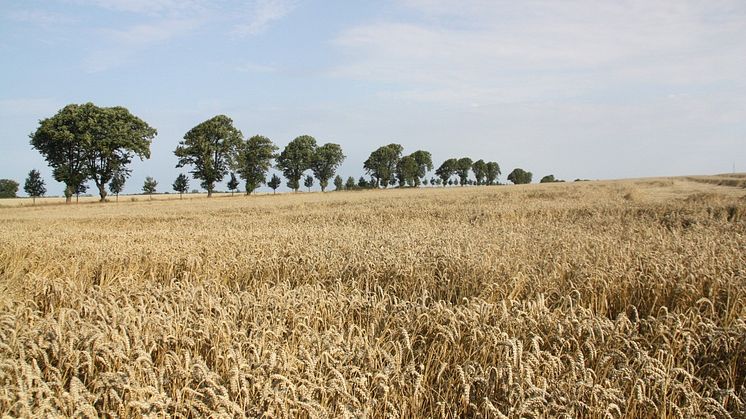
Nyhed -
Pilot programs that make a difference
1.Short Bio – David Kamau
David Kamau is a seasoned business executive with over 20 years’ experience in the pharmaceutical and Fast-Moving Consumer Goods industries having worked for leading multinational, regional and local companies. David currently serves as the Managing Director of the Fortified Whole Grain Alliance and oversees the Alliance activities across Low- and Middle-Income countries globally but with a focus on Sub-Sahara Africa.
David holds a Bachelor of Science degree (Fisheries) from Moi University in Eldoret; Kenya and earned an MBA in Strategic Management from the University of Nairobi in Kenya and has further been awarded the designation of Chartered Marketer SA by the Marketing Association of South Africa (CMSA). He has also extensive trainings in management and leadership from various global institutions inclusive of a Food Systems Live executive certificate from Harvard University; USA.
2.Who is the Fortified Whole Grain Alliance (FWGA) and what is the alliance’s most important goal?
The Fortified Whole Grain Alliance (FWGA) is an Africa-based coalition of stakeholders that span across the food system, including non-profit and private sector members, committed to increasing the global consumption of Fortified Whole Grains (FWGs). The purpose of the Alliance is to sustainably improve the diets of school children, vulnerable populations, and eventually whole populations through increased consumption of fortified whole grain foods.
The Fortified Whole Grain Alliance was founded by partners who share a common vision regarding the FWGA’s objectives and purpose. The Alliance partners are involved in joint resource contributions, shared risks and joint ownership of and access to information and they aim to use their institutional capabilities and networks to maximize the impact of the Alliance.
The key pillars that drive the Alliance activities, namely advocacy & social marketing, research & development, policy & institutional capacity development and data analytics and evidence generation are critical in driving the local supply of FWG in the countries of focus.
The continued support which the FWGA offers includes:
•Expertise & operational capacity directly to millers through our technical lead’s support.
•Research & development activities that focus on the increased shelf life, nutritional quality and consumer desirability of fortified whole grains as well as identification and installation of processing equipment.
•The generation of data, analytics and evidence through building the evidence base for FWGs, through monitoring and evaluation efforts, data compilation with our partners and evidence synthesis.
•Advocacy and social marketing through generating consumer insights to better understand consumption habits and patterns.
•Policy and institutional capacity through working with the Alliance partners and members to develop policies, regulations and legislation that will assist in promotion of the production and consumption of FWG in the region.
3.FWGA has started school feeding programs. Can you tell us about the programs in Burundi and Kenya?
Kenya: The Fortified Whole Grain Alliance supported a pilot program in Murang’a County that looked at introducing Fortified Whole Grain Porridge to ECD centers. The pilot aimed at evaluating the feasibility and acceptability of the uji/porridge pilot.
Under the study, 95 centers involving 72 head teachers, 95 center managers, 95 children, 30 motorbike operators and 16 cooks participated. Observation data were grouped based on predetermined themes. The pilot demonstrated utility in mitigating school hunger and promoting the development of young ECD going children. Further, bulk sourcing and centralized production units illustrated efficiencies in financial and energy costs compared to previous interventions.
Fortified Whole Grain Millet and Fortified Whole Grain Maize Meal porridge flours were preferred to other flours that were included in the study. At the end of the pilot, the final flour mix utilized a 90:10 ratio of Fortified Whole Grain Maize Meal flour to Fortified Whole Grain Millet flour. The final flour blend considered the health benefits as well as the consumer preferences gathered through parent and center manager interviews.
The provision of porridge in ECD centers during the pilot contributed to reduced absenteeism, where 4.2% of the schools reported an increase in enrolment. In some cases, children who had initially dropped out of school, resumed. 67.4% of learners attended school more consistently due to the assurance of getting a cup of porridge every school day. It was observed that the pupils were excited to attend school even on rainy days. Parents reported that the program had saved on the cost and time required to prepare midmorning snacks and further to this, parents benefited from employment opportunities as cooks and riders’ distribution the porridge to various ECD centers.
From a cost perspective during the pilot, the porridge (uji) was served to 20,004 learners in ECD schools and was delivered at Ksh 4 per cup cheaper than previous porridge (uji) programs. This represented a 36% saving to the Murang'a County Government which equates to over KES 31 million saved over a 12-month period.
In summary, from the pilot program, 294,688 cups of uji were delivered to 20,004 beneficiaries across 314 ECD centers, within 17 wards. The final flour blend considered health benefits, consumer preferences and price sensitivities, and utilized a 90:10 ratio of Fortified Whole Grain Maize Meal flour to Fortified Whole Grain Millet flour. 77.3% of the respondents stated that the piloted model was better than previous offering, indicating reduced financial and logistical commitments to the county Government and trust emerged as a major theme in promoting acceptability and ownership.
Following the success of the pilot program, the county government has now scaled up the feeding of children in ECD centers in Murang’a and they are now feeding all the 40,000 children in ECD centers in Murang’a County. The FWGA team is in discussion with various other county governments around the county to replicate the same and provide healthy and nutritious porridge to all learners.
Burundi: Burundi is a densely populated and landlocked country that ranks among the poorest nations on earth. Its chronic malnutrition rate, which stands at a staggering 55.8%, is preventing growth and development of the country’s human capital. To address this critical issue, the World Food Program (WFP) is taking a sustainable food systems approach to assist smallholder farmers, food value chains actors and school-aged children in Burundi. By enabling access to resilient, healthier and nutrition-sensitive food systems, The Rockefeller Foundation’s Power of Procurement for Nutrition (PP4N) initiative seeks to develop healthy diets by improving nutrition through institutional procurement channels like school feeding.
The Government of Burundi has made significant efforts to strengthen the national school feeding program and improve the policy environment. Home-grown school feeding programs have been identified as an essential social safety net program offering institutional market access to local smallholder farmers. The objective is to achieve universal coverage of school feeding in Burundi by 2032. Burundi is a member of the School Meals Coalition since August 2021 and is committed to join East Africa Sub-Regional Network School Meals Coalition launched in May 2023.
In 2022, WFP supported the implementation of national school feeding program in providing nutritious meals to 660,000 children across 850 schools, representing 24% of the 2.8 million school-aged children in Burundi. WFP Burundi advanced considerable technical support to three medium scale-milling companies to produce high quality FWG. As a result of PP4N’s support, the three milling companies were able to produce their first FWG prototype in December 2022 and FWG food production was launched in April 2023. The launch was graced by the 1st lady of Burundi who is the champion of nutrition & school feeding in Burundi. There were various government ministries in attendance such as the Minister of trade, the RF Africa VP and foods team, the WFP RB team and representatives of various bilateral organizations.
Following the launch in April, the number of school children benefiting from FWG foods in schools has increased from the initial 45,000 to approximately 200,000 and this is expected to continue growing. Scale up of the school feeding is expected to be done to 10-15 millers to enable the supply of FWG to all school children and the increase in the production capacity shall be mapped to the institutional demand.
4. What are your experiences so far?
There is a significant opportunity for us to change the narrative of provision of healthy and nutritious foods to our school children in low- and middle-income countries (LMICs) with many LMICs currently facing the rising double burden of malnutrition.
My experience and learnings thus far based on progress we have made in Rwanda, Burundi and Kenya are the following: -
a) There must be commitments from governments to achieve large scale school feeding in the countries where we operate. Commitments are not only financial but will also include legislative changes to enable increased production & consumption of fortified whole grain foods.
b) Policies that support the work that we are undertaking will need to be in place and these will make implementation easier e.g., standards need to be developed that support the provision of FWG foods in different markets.
c) Starting with demand in institutional markets such as schools in school feeding programs is an impactful way of creating positive lifelong consumption habits.D
d) Innovation that drives cost effective scalable solutions is important to drive increased production, especially with millers who have already invested in processing equipment. We have seen this impact through the drying solution proposed to reduce the moisture content of maize and we have presented this to millers across the region.
e) Social Behavior change is important to growing awareness of the benefits of consumption of FWG foods. In both Kenya and Rwanda, we saw the spontaneous demand from parents of school children who were receiving FWG food in school and they were sourcing for the FWG flour in the open markets. A well thought through and purposed social and behavior communication change campaign will have a positive impact in creating lasting demand and behavior change amongst the population.
5. How have the children reacted on the whole grain meal?
In the countries where this has been adopted, i.e. in Rwanda, Burundi and Kenya, the FWG foods have been very well accepted by the school children. The biggest reason for this is due to the taste preference of FWG maize flour that is prepared either as ‘Ugali’ (Maize meal) or as ‘Uji’ (porridge).
6. What challenges have you experienced?
We have experienced a wide variety of challenges in the different countries that we operate in, however, we always look at mitigating these challenges as we go about implementing the programs. In summary, the general challenges faced are as follows:
•Lack of government engagement leads to delays in decision making e.g. in procurement.
•Low in-country agricultural production & poor-quality grains i.e. maize & wheat limit scale up of home-grown school feeding programs.
•High costs and delays in implementation of food safety quality processes (including aflatoxin testing).
•Lack of appropriate standards, including from a regional perspective (East African or ECOWAS).
•Lack of miller incentives due to lower demand for FWG products.
•Fragmentation of the milling sector makes it difficult to aggregate supply.
•Decentralized procurement at the school level makes it difficult to build long-term contracts with millers.
7. What has surprised you the most in the work done up to now?
Generally, there is high awareness of the benefits of consuming whole grain foods, however this awareness does not translate into consumption of these FWG foods due to several barriers to consumption. There is a clear opportunity to leverage on the existing awareness and change the narrative towards acceptance of these FWG foods and a social and behavior communication change campaign will nudge consumers towards adopting healthier eating habits.
The benefits of fortification are not fully accepted and there needs to be efforts in creating awareness and benefits of fortifying foods. Some countries such as Kenya have made the fortification of flours mandatory however in other countries and regions in LMICs, fortification is looked at suspiciously and is yet to be embraced by governments.



